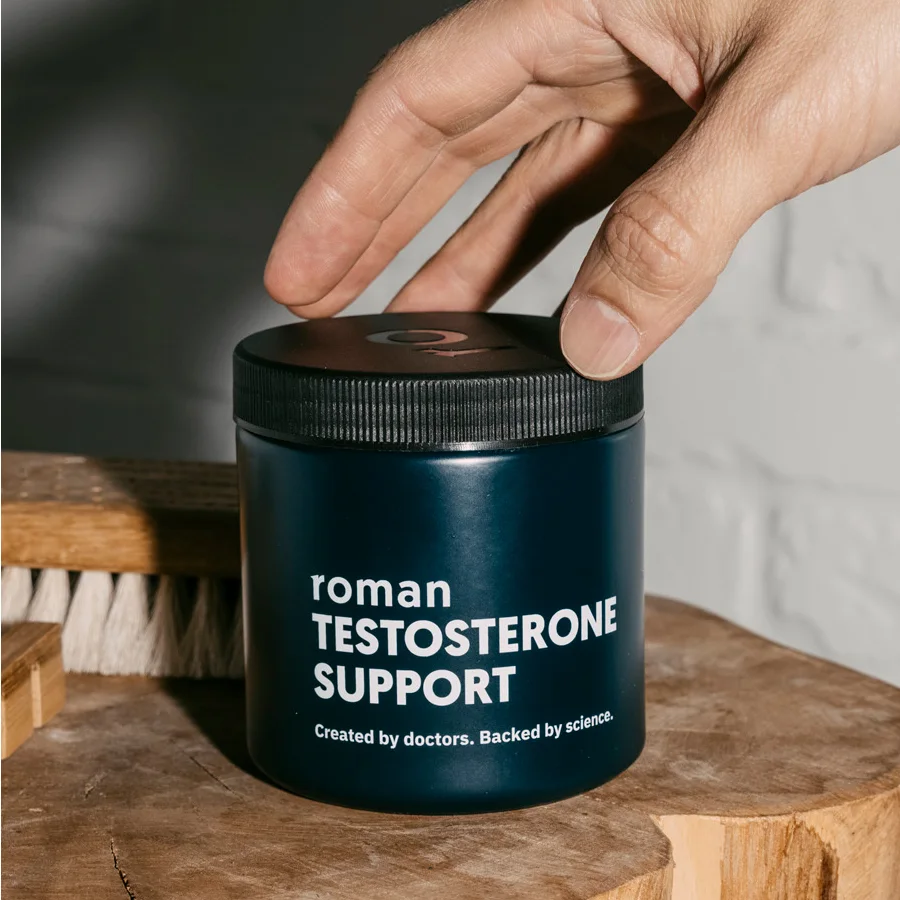Here's what we'll cover
Here's what we'll cover
Here's what we'll cover
Did you know that testosterone comes in a gel that can be absorbed through your skin? This easy-to-use prescription medication is used for a few different conditions where increased testosterone levels can be beneficial.
What is low testosterone?
As men age, their testosterone levels naturally lower. Certain genetic conditions and diseases can cause low testosterone (also called low T or hypogonadism) too. For example, cancer, chronic kidney disease, sleep apnea, and obesity all can cause testosterone levels to take a dip (Petering, 2017).
When men with low T are symptomatic, testosterone replacement is the mainstay of treatment. An important thing to note is that testosterone therapy can have significant side effects––especially in older adults and women––like skin irritation and acne (more on those later).
What is testosterone gel?
Testosterone gel is a form of testosterone replacement therapy sometimes used for those who have hypogonadism or transgender men experiencing gender dysphoria. The gel comes in a dosing pump and is available under a few different brands including (Petering, 2017):
Androgel 1% or 1.62% (topical gel)
Fortesta (topical gel)
Testim 1% (topical gel)
Natesto (nasal gel)
Testosterone gel should be applied once a day to clean, dry, and unbroken skin––a good spot is the shoulder or upper arm. If you’re using gel or a topical solution don't apply it to other areas of the body like the abdomen or scrotum (Petering, 2017).
You should also rotate the application area to avoid skin irritation. To lower the risk of exposing someone else to hormones, you can apply the treatment to a part of your arm that can be covered up.
When using testosterone gel, avoid contact with water for at least five hours after applying it to your skin. The amount of gel you need varies depending on the dosing prescribed by a healthcare provider.
Studies show that the gel version of testosterone is safe and effective for the symptoms of hypogonadism (Belkoff, 2018). Testosterone gel can also be a beneficial option for those who don’t want to give themselves injections.
What does testosterone gel treat?
Testosterone is an androgen (a type of sex hormone) responsible for many things in both men and women. Most people know it plays a big role in the changes men undergo during puberty including (Nassar, 2022):
An increase in muscle mass
Deepening of the voice
Body hair growth
But testosterone doesn’t stop being important after puberty—it plays a life-long role in your health. Having low T is associated with changes in sex drive, bone strength, higher cholesterol, and even depression (Nassar, 2022).
Testosterone therapy has been studied mainly in two settings:
Hypogonadism: Studies suggest that hormone therapy with testosterone gel benefits sexual function, bone mineral density, and mood in cis men. Data also shows that the gel is comparable to injectable testosterone for treating delayed puberty in young males (Snyder, 2018; Chioma, 2017).
Gender dysphoria: Many transgender men seek testosterone therapy as a part of transitioning. In addition to physical masculinization benefits, testosterone has beneficial effects on depression, social distress, anxiety, and general dysphoria. The exact dosage and approach can be tailored to an individual’s needs, though this is still an emerging field and further research is needed (Unger, 2016).
Potential side effects of testosterone gel
The most common side effects of testosterone gel are skin irritation at the application site and acne.
Other possible side effects are an enlarged prostate, headaches, increased hematocrit count (red blood cells), and nasal discomfort. If you use these gels, you also risk transferring the hormones to others (like children) via skin-to-skin contact (Lakshman, 2009).
It’s important that a healthcare professional closely monitors any side effects for safe testosterone administration. Your provider may utilize blood tests to make sure your testosterone levels are at the appropriate spot on this treatment (Sansone, 2019).
Studies show that older people with pre-existing medical conditions are at a higher risk of side effects—especially with problems related to the heart. Older men with chronic illnesses like heart failure experienced a higher rate of heart attacks (Snyder, 2018; Basaria, 2010).
The U.S. Food and Drug Administration (FDA) has put out a drug safety notification, requiring manufacturers of testosterone products to put a warning on labels about the increased risk for heart attacks and stroke in older men (FDA, 2018).
In addition to older individuals, testosterone may be harmful in people with blood clots and liver issues. Testosterone therapy may increase your prostate-specific antigen (PSA) blood test levels (a measure for prostate cancer), but this may not be clinically significant (Petering, 2017).
People with prostate or breast cancer should not use testosterone. Avoid this product if you’re pregnant or breastfeeding. There is also a risk that testosterone can interact with other medications you take. Talk to your healthcare provider for medical advice before starting testosterone therapy.
DISCLAIMER
If you have any medical questions or concerns, please talk to your healthcare provider. The articles on Health Guide are underpinned by peer-reviewed research and information drawn from medical societies and governmental agencies. However, they are not a substitute for professional medical advice, diagnosis, or treatment.
References
Basaria, S., Coviello, A. D., Travison, T. G., Storer, T. W., Farwell, W. R., Jette, A. M., et al. (2010). Adverse events associated with testosterone administration. The New England Journal of Medicine , 363 (2), 109–122. doi:10.1056/NEJMoa1000485. Retrieved from https://www.nejm.org/doi/full/10.1056/NEJMoa1000485
Belkoff, L., Brock, G., Carrara, D., Neijber, A., Ando, M., & Mitchel, J. (2018). Efficacy and safety of testosterone replacement gel for treating hypogonadism in men: Phase III open-label studies. Andrologia , 50 (1), doi:10.1111/and.12801. Retrieved from https://pubmed.ncbi.nlm.nih.gov/28295450/
Chioma, L., Papucci, G., Fintini, D., & Cappa, M. (2018). Use of testosterone gel compared to intramuscular formulation for puberty induction in males with constitutional delay of growth and puberty: a preliminary study. Journal of Endocrinological Investigation , 41 (2), 259–263. doi:10.1007/s40618-017-0726-7. Retrieved from https://pubmed.ncbi.nlm.nih.gov/28695484/
Lakshman, K. M. & Basaria, S. (2009). Safety and efficacy of testosterone gel in the treatment of male hypogonadism. Clinical Interventions in Aging , 4, 397–412. doi:10.2147/cia.s4466. Retrieved from https://pubmed.ncbi.nlm.nih.gov/19966909/
Nassar, G. N. & Leslie, S. W. (2022). Physiology, testosterone. [Updated Jan. 4, 2022]. In: StatPearls [Internet]. Retrieved on Jan. 26, 2022 from https://pubmed.ncbi.nlm.nih.gov/30252384/
Petering, R. C. & Brooks, N. A. (2017). Testosterone therapy: review of clinical applications. American Family Physician , 96 (7), 441–449. Retrieved from https://pubmed.ncbi.nlm.nih.gov/29094914/
Sansone, A., Sansone, M., Selleri, R., Schiavo, A., Gianfrilli, D., Pozza, C., et al. (2019). Monitoring testosterone replacement therapy with transdermal gel: when and how? Journal of Endocrinological Investigation , 42 (12), 1491–1496. doi:10.1007/s40618-019-01082-x. Retrieved from https://pubmed.ncbi.nlm.nih.gov/31267510/
Snyder, P. J., Bhasin, S., Cunningham, G. R., Matsumoto, A. M., Stephens-Shields, A. J., Cauley, J. A., et al. (2018). Lessons from the testosterone trials. Endocrine Reviews , 39 (3), 369–386. doi:10.1210/er.2017-00234. Retrieved from https://pubmed.ncbi.nlm.nih.gov/29522088/
Unger, C. A. (2016). Hormone therapy for transgender patients. Translational Andrology and Urology , 5 (6), 877–884. doi:10.21037/tau.2016.09.04. Retrieved from https://pubmed.ncbi.nlm.nih.gov/28078219/
U. S. Food and Drug Administration (FDA). (2018). FDA Drug Safety Communication: FDA cautions about using testosterone products for low testosterone due to aging; requires labeling change to inform of possible increased risk of heart attack and stroke with use. Retrieved on Jan. 26, 2022 from https://www.fda.gov/drugs/drug-safety-and-availability/fda-drug-safety-communication-fda-cautions-about-using-testosterone-products-low-testosterone-due












